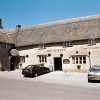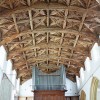He was born into the hurly-burly of early Victorian Dorchester but laid to rest in the colonial soil of Tasmania. He showed small promise of any artistic talent as a child, yet at the end of his days his works were better known throughout the largest island outpost of the British Empire than in the land of his birth. And no-one, least of all his parents, could have imagined that his future would lie in committing the raw primeval beauty of the antipodean outback to canvas.
Thomas William Roberts was born in Dorchester on March 9th, 1856, the son of a printer and reporter, Richard Roberts, then a sub-editor of the Dorset County Chronicle. Richard had married Tom’s mother, a Londoner named Matilda Agnes Cela Evans, in Shrewsbury early in 1851, and the census of that year showed that at that time he was still living with his parents, Thomas Roberts (50), described as a Brass Founder and his wife Hannah (48) both born in Shrewsbury. By 1861 however, Richard and Matilda had moved to Dorchester, having taken up residence in house in Fordington High Street. Their household consisted of Thomas, then 5, a one-year-old daughter, Alice Matilda, and an 11-year-old housemaid named Mary Wills.
Tom attended Dorchester Grammar School where he received a thorough grounding in the classics, learning quotations in Latin he was able to recall years later. During these schooldays his greatest accolade was winning a prize for scripture he later explained, “not by answering the question directly but by imaginatively writing on a related subject.”
On 30th December 1868, when Thomas was about 13 his father who was then editor of the Dorchester newspaper died aged only 41 at Wollaston Villas, All Saints Dorchester, leaving the family impoverished. His widow then courageously resolved that she and her children should leave to seek a new life in the then developing colony of Australia. A married sister had herself emigrated to there some years before, so that the sisters could be re-united. Tom Roberts’ first home in his adopted country was a modest one in Dight Street, Collingwood, a suburb of Melbourne.
But the position Roberts was now in determined that he could not resume any schooling, but had to find some employment at once. He soon found a position as an assistant to a local commercial photographer, but the job entailed long hours for small pay. To supplement a meagre income his mother took on the job of making school satchels as an outworker under her brother-in-law, who ran a leather goods business. During this time Tom would help his mother in the evenings by cutting out the straps for the bags. He would later write that his mother “was the bravest woman I ever met.”
After a time, Thomas’ “bulldog” qualities helped him find better employment with Stewarts, the leading commercial photographers in Melbourne. Here he progressed rapidly and showed an early artistic bent when, for a commercial portrait, he hit on the idea of using a background of tea-tree boughs instead of the conventional classical one of mock pillars and curtains fashionable at the time.
The government had embarked on a programme of establishing design schools in the state capitals and Melbourne (Victoria) was no exception. By the time he was just 19 Tom had become Stewarts deputy manager yet he took a course to study design at a new state design school founded at Collingwood, where he won the annual prize in 1875.
From this school Roberts progressed to the National Gallery Art School, usually known by its pet-name of “The Tank.” Here his talent caught the attention of the drawing class overseer, Thomas Clarke, who advised him to go to study in Europe. The gallery had only an un-coordinated training and no life-class, the training consisting mainly of copying the gallery’s own mediocre pictures. Taking the school’s dissolute students under his own wing, Roberts broke away to set up on his own.
Stewart allowed Tom to attend a half-day-a-week painting class, where he exhibited his first major picture in the photographic studio. The sale of this picture, together with earnings from local newspaper reproductions and other monochrome drawings, paid Roberts his passage back to England in 1881.
The following year found the now fully professional, dedicated 25-year-old artist studying hard at the Royal Academy. His drawings were in demand from ‘The Graphic’ and other periodicals. But then another person entered his life who was to have a marked influence upon him: painter Bastien Lepage, a protégé of the French impressionists under who’s spell Roberts himself was to fall. Studying their work, Roberts then eschewed the conventional academic school for a broader horizon.
The flourishing painter’s next move was to undertake a tour of Spain in the company of Dr. William Maloney, the artist John Russell and Sydney Russell, an architect. At one time the four nearly became embroiled in Spain’s political upheavals as partisans, but an encounter with Barrau and Casas, two first-rate pupils of Gerome was to have an outstanding impact on Roberts and his Australian contemporaries in turn. They taught him that in painting he should first seek ‘the general impression of colour.’ On his return from Spain Robert’s sketches of the country made a deep impression on Arthur Streeton and Charles Condor, two fellow artists with whom he was soon to share a close professional relationship.
However for a time Roberts fell in with an artist called McCubbin, with whom he set up a painting camp at Box Hill, Melbourne. Here they were joined by Louis Abrahams though Roberts, not content with mere landscapes, sought to record the active life of the bush. After a time Roberts and McCubbin rented a coastal shack at Mentone near Melbourne, where the former first encountered Streeton, a talented lithographer, and invited him to make a trio at Mentone. Visiting Sydney, Roberts then fell in with Charles Condor, who extended the specialist school to a quartet.
In 1887 Streeton realised that a derelict 8-roomed timber house he had come across on a hill above Heidelburg would be the ideal homebase for a painting school. The building commanded a spectacular view over the Yarra basin to the Blue Hills, and Streeton was soon joined by Roberts and Conder. It was here, between 1889 and 1891 that Roberts painted two of what are considered his finest canvases: “The Breakaway” and “Shearing the Rams.” In 1895 he began another great impressionistic bush ranging picture “Bailed Up,” but then put it aside for another 30 years before finishing it.
Conder later left the school to work in Paris, but not before the group staged an exhibition of 9×5 inch “cigar-box lid” impressionistic paintings in Melbourne. By then Australia was in the grip of a recession, though Roberts was largely unaffected and in 1896 became engaged to and married a local woman, Elizabeth Williamson. Their only child, a son Caleb, was born in 1898.
In 1901 Tom Roberts was again preparing to return to England when he held, at the Society of Artists rooms in Pitt Street, Sydney, an exhibition of paintings for sale at between two and seventy guineas. But then the landing of a prestigious commission forced the artist to abandon his travel plans. It was federation year, the event marking the historic unification of the seven colonial states into the Commonwealth of Australia. To mark the occasion the Australian Art Society commissioned a Melbourne artist for an 18×12 foot canvas for the opening of the Parliament building by the Duke of York. When this painter had to withdraw due to illness Roberts was offered the commission instead.
The artist then embarked on a tour of the country, sketching all the political figures and scenes to be featured. Although the fee was 1000 guineas, Roberts would come to regret his decision to accept the mammoth project, which would take him two years to complete. The picture is now mounted in St. James’ Palace, London.
By now Roberts was back in England with his family in hopeful expectation of further portrait commissions. Troubled by the notion that his technical skill was falling below his earlier high standard, he seriously considered painting ‘pot-boilers’ for the London market. The dark clouds passed however, after friends prevailed upon him to exhibit at the Walkers Gallery in New Bond Street.
On the outbreak of the First World War, Tom Roberts and his friends rushed to enlist in the volunteers. Tom was posted to carry out menial tasks at Wandsworth Military Hospital, giving up painting entirely for he was never offered an official artist position. Demobbed as a Sergeant in the RAMC, he returned alone to Australia in 1919 for a one-year extended vacation, retreating to the Dandenong Ranges to seek solitude and inspiration for more landscapes. The following March he held a one-man exhibition, returning yet again to England at the end of 1920 to rejoin Elizabeth and Caleb.
This last furlough in his mother country lasted three years until 1923, whereupon Roberts returned with his family to his beloved Dandenongs, this time for good. He built a cottage home “Talisman” in the village of Kallista, and resumed his painting, seemingly amid a whirl or renewed creative energy and discernment. In 1927, when Roberts was 72, Elizabeth died, yet the aging painter could not remain inactive, and the following year he visited Apollo Bay, the Goulburn Valley and Tasmania.
Jean Boyes, for sometime a friend of Tom, became the widower’s second wife in August 1928, the couple making a new home for themselves in Tasmania. In 1930 they returned to Kallista, and it was here, on September 14th, 1931 that Thomas Roberts died, aged 75. In accordance with his will his body was taken back to Tasmania and buried in the quiet churchyard of the village of Illawarra.
Truly, Thomas Roberts was ahead of his time as a pioneer global commuter in an age when many country people would never travel more than a few miles from their place of birth. His is a legacy Dorset can be proud of in having given birth to him.



